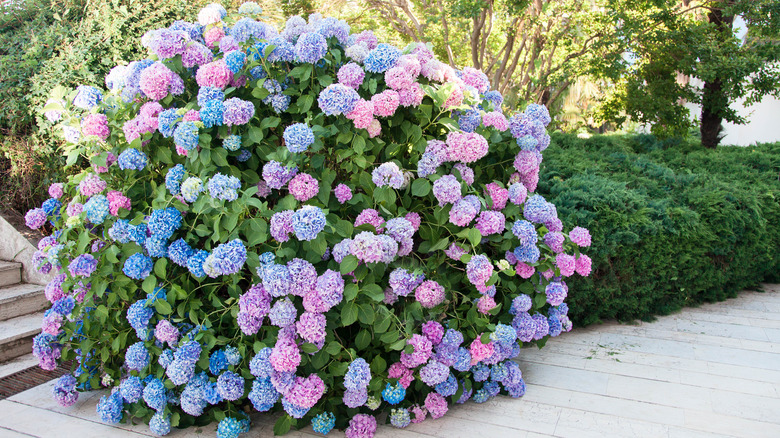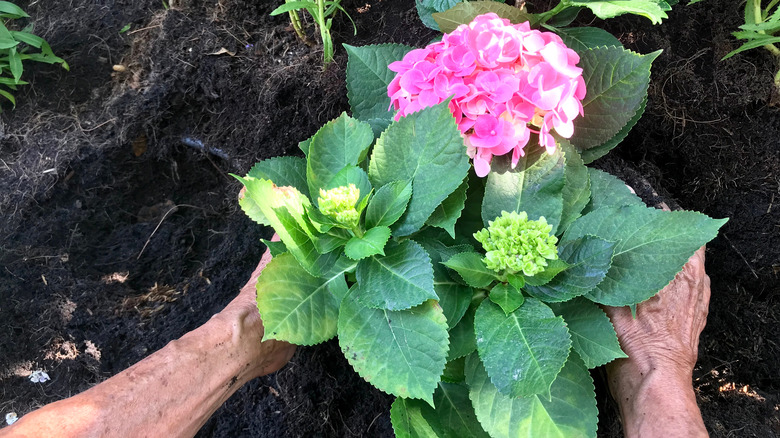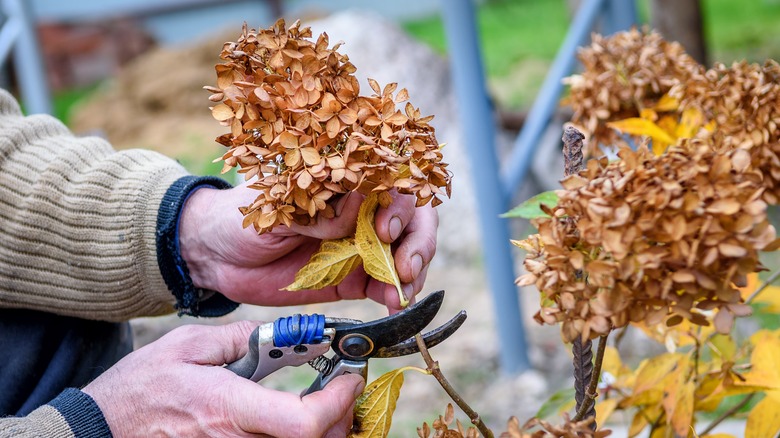How To Best Prep Your Hydrangeas For Spring To Ensure Stunning Blooms
Hydrangeas, with their large dramatic blooms, are some of the most beautiful and low-maintenance shrubs you can have in your landscape. Their gorgeous flowers come in a variety of colors, which often change with age or in response to soil pH. Spring fertilizing and careful pruning will ensure your hydrangeas impress all season long.
There are multiple species within the larger Hydrangea genus, and knowing what type you have in your garden is essential to taking care of your hydrangeas. Some of the most popular types of hydrangeas for landscaping are bigleaf hydrangeas (Hydrangea macrophylla), smooth hydrangeas (Hydrangea arborescens), and panicle hydrangeas (Hydrangea paniculata). While smooth hydrangeas are hardy in zones 4 through 9 and panicle hydrangeas are hardy in USDA zones 4 through 8a, most cultivars of bigleaf hydrangea are only hardy down to zone 6 and often struggle to flower in colder zones. Ohio State University Extension notes that even hydrangeas labeled for full sun will likely grow better in part-shade locations as hydrangeas are woodland plants that benefit from some protection from the sun. Hydrangeas also grow best in loamy soil and often struggle in clay-heavy regions unless the soil is heavily amended with compost.
Fertilizing hydrangeas
Hydrangeas benefit from fertilizing in early spring or late winter as they begin to break dormancy. A balanced slow-release fertilizer is generally best, as too much nitrogen can encourage leaf growth at the expense of blooms. Overfertilized hydrangeas can suffer from leaf scorch.
Hydrangeas grow best in acidic soils, and spring is the perfect time to measure the pH of your soil and ensure that it is between 5 and 6. The flowers on many cultivars of bigleaf hydrangeas can even change color in response to soil pH, often turning blue if the pH is below 5.5 and changing to pink at higher pHs. While most other types of hydrangeas will not change color in response to pH, they still grow best in more acidic soil. If your soil's pH is not ideal for your hydrangeas, spring is the time to begin carefully adding lime to raise the pH or sulfur to lower it if necessary. You should do this gradually to avoid overcorrecting.
Pruning hydrangeas
It's best to prune all species of hydrangeas in spring, allowing the plants to spend the winter with their beautiful dried flowers. This doesn't just provide you with winter interest in the garden, it also helps to protect your plants. Autumn pruning can increase the risk of winter injury for the plants, often reducing the number of blooms the hydrangea will produce the next year.
It's imperative to know what type of hydrangea you have before you start pruning, as pruning mistakes can easily result in shrubs completely bereft of blooms. This is because while panicle and smooth hydrangeas bloom on new growth — that is, on buds that emerge early in spring — bigleaf hydrangeas bloom on old wood, and trimming back the previous year's growth can easily remove these flower buds. You can safely trim back your panicle and smooth hydrangeas in late winter or early spring before they break dormancy. For your bigleaf hydrangeas, it's best to remove dead and damaged branches only after the plant breaks dormancy and you can clearly see where the buds are. More significant pruning should not be done until immediately after your big leaf hydrangea has finished blooming for the spring.


